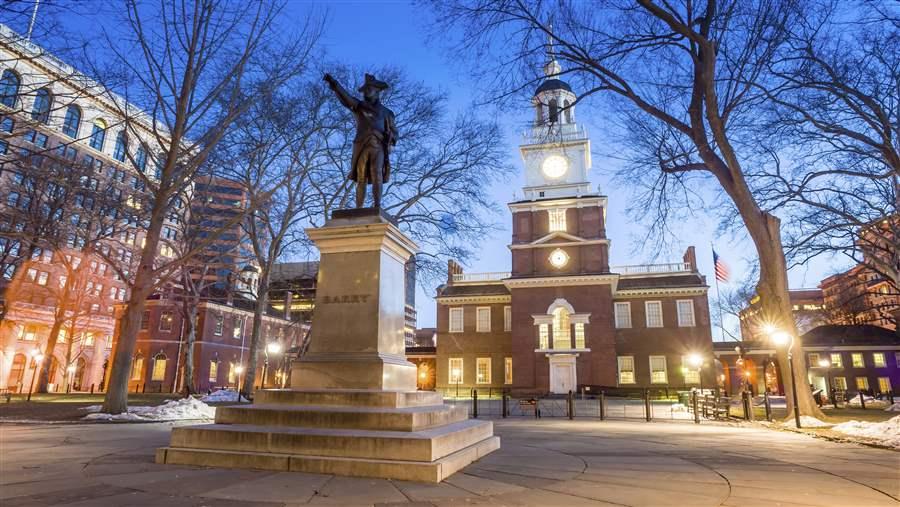A Golden Era for Philadelphia Tourism
What do Pope Francis, singer and human rights advocate Bono, and both the Republican and Democratic national committees have in common? In the last two decades, they chose Philadelphia as the best place to advance their values and mission. And the audience was worldwide.
Twenty years ago, Google was still a research project at Stanford. The iPhone was more than a decade away. And Netflix hadn’t started mailing DVDs.
We didn’t foresee these remarkable changes in the way Americans live, work, and spend leisure time. But in an op-ed we wrote for The Inquirer in 1996, we recognized that Philadelphia was being “out-hustled and outspent” by other East Coast cities in the competition for hospitality dollars. Tourists literally treated Philadelphia as a drive-by city—assuming they could find the exit off I-95—on their way to overnight stays in New York City or Washington. But we argued that Philadelphia’s golden promise—its potential to create thousands of jobs and add millions of dollars to the economy by becoming a successful tourist destination—could be reached through a strong public-private partnership committed to aggressively marketing our region’s unique history, culture, and location.
To that end, the Pew Charitable Trusts, the commonwealth of Pennsylvania, and city of Philadelphia pooled their resources and created the Greater Philadelphia Tourism Marketing Corp.—now known as Visit Philadelphia —which this month celebrates its 20th anniversary. Together, we launched Visit Philadelphia, and with support from community leaders and businesses—and the bipartisan approval of a 1 percent hotel tax in 1999—Visit Philadelphia has flourished, successfully marketing the Philadelphia region.
Our vision of Philadelphia as a destination for millions of visitors required dramatic changes to Independence Mall, the three-block area of Independence National Historical Park that is home to many of Philadelphia’s most treasured sites. In 2001, the Independence Visitor Center—a $40 million public-private project—opened in partnership with the National Park Service, and welcomes more than 2 million people annually.
Other important public-private investments in the city’s historical and cultural legacy include restoration of the Benjamin Franklin Parkway with new lighting and landscaping; the remaking of Sister Cities Park; and a beautiful museum to house the Barnes Foundation’s collection of masterpieces. There is also the new Liberty Bell Center and the Benjamin Franklin Museum, which reopened in 2013 after an $18 million renovation on the site of Franklin’s former Philadelphia home. The National Constitution Center, which opened in 2003, continues to produce thought-provoking programming while encouraging civic understanding of—and debate about—the American Constitution.
There is a famous line from the movie Field of Dreams: “If you build it, they will come.” But that’s not the way things work in real life. Yes, through advocacy and vigorous fund-raising, we were able to build the Visitors Center and restore Independence Mall. However, to put Philadelphia on the must-see list of millions of visitors, we needed to do more than “build it.” We needed an innovative marketing strategy to promote awareness of Philadelphia’s historic and cultural treasures. That’s what Visit Philadelphia has done—with a strong and integrated mix of advertising, a million social media followers, and 19 million web visits last year; news and feature articles, including 8,000 stories in 2015; sponsorships; and effective partnerships with the public and private sectors.
The results speak for themselves. In 2015, the region welcomed a record 41 million domestic visitors, up from 27 million in 1996. Spending from these visitors generated $10.7 billion in economic activity, supported more than 93,000 jobs, and brought in $612 million in state and local taxes. Today, one out of three hotel rooms occupied in Center City is for a leisure stay.
The dramatic increase in Philadelphia tourism is a virtuous cycle: more positive media attention and advertising bring more visitors, and more visitors bring more positive media attention. Last year, The New York Times placed Philadelphia third among its “52 Best Places to Go in 2015,” behind only Milan, Italy, and Cuba. And the travel authority Lonely Planet ranked Philadelphia number one on its list of “10 best places to visit in the United States in 2016.” Philadelphia was also recently named our nation’s first World Heritage City because of its iconic landmarks and its unique role as the cradle of American liberty and democracy.
Although Philadelphia is one of America’s oldest cities, it has become a favorite of young people. The New York Times wrote the first of many articles touting Philadelphia’s increasing popularity among millennials back in 2005. In the six years that followed, the millennial population increased by 100,000—the largest percentage growth of any major U.S. city.
Twenty years ago we wrote, “It is time to reclaim our place in the hearts and minds of America and to make this region once again a place where people want to come, choose to linger, and look forward to returning.” That was Philadelphia tourism’s golden promise. Two decades later we have reached a golden era for the city’s tourism and hospitality industry. There is still work to be done, and as we did 20 years ago, we’re asking those who live and work here to help tell our region’s story—that Philadelphia is a vibrant 21st-century city, with a rich history and exciting future, and we are eager to share it with visitors from around the world.
Edward G. Rendell and Thomas J. Ridge are former governors of Pennsylvania; Mr. Rendell is also the former mayor of Philadelphia. Rebecca W. Rimel is president and CEO of the Pew Charitable Trusts.
This op-ed initially appeared in The Philadelphia Inquirer on September 13, 2016.







